PUBH1080: Metabolic Disorders and Antipsychotic Medications
VerifiedAdded on 2022/10/17
|19
|4473
|313
Report
AI Summary
This critical literature review examines the relationship between metabolic disorders and antipsychotic medications in adults under 50. The report explores the causes of metabolic dysfunction, including lifestyle factors like inactivity and poor diet, as well as genetic predispositions. It investigates the impact of antipsychotic medications on metabolic processes, such as increased risk of diabetes, hyperlipidemia, and cardiovascular diseases, as well as their effects on mental well-being. The review synthesizes findings from various studies, including observational studies and RCTs, to identify research gaps and offer recommendations for practice. The discussion highlights the interconnectedness of physical and mental health, emphasizing the importance of physical activity, healthy eating habits, and mental wellness strategies alongside antipsychotic treatment. The report aims to provide a comprehensive overview of the current understanding of these complex health issues and suggest areas for future research and clinical practice.
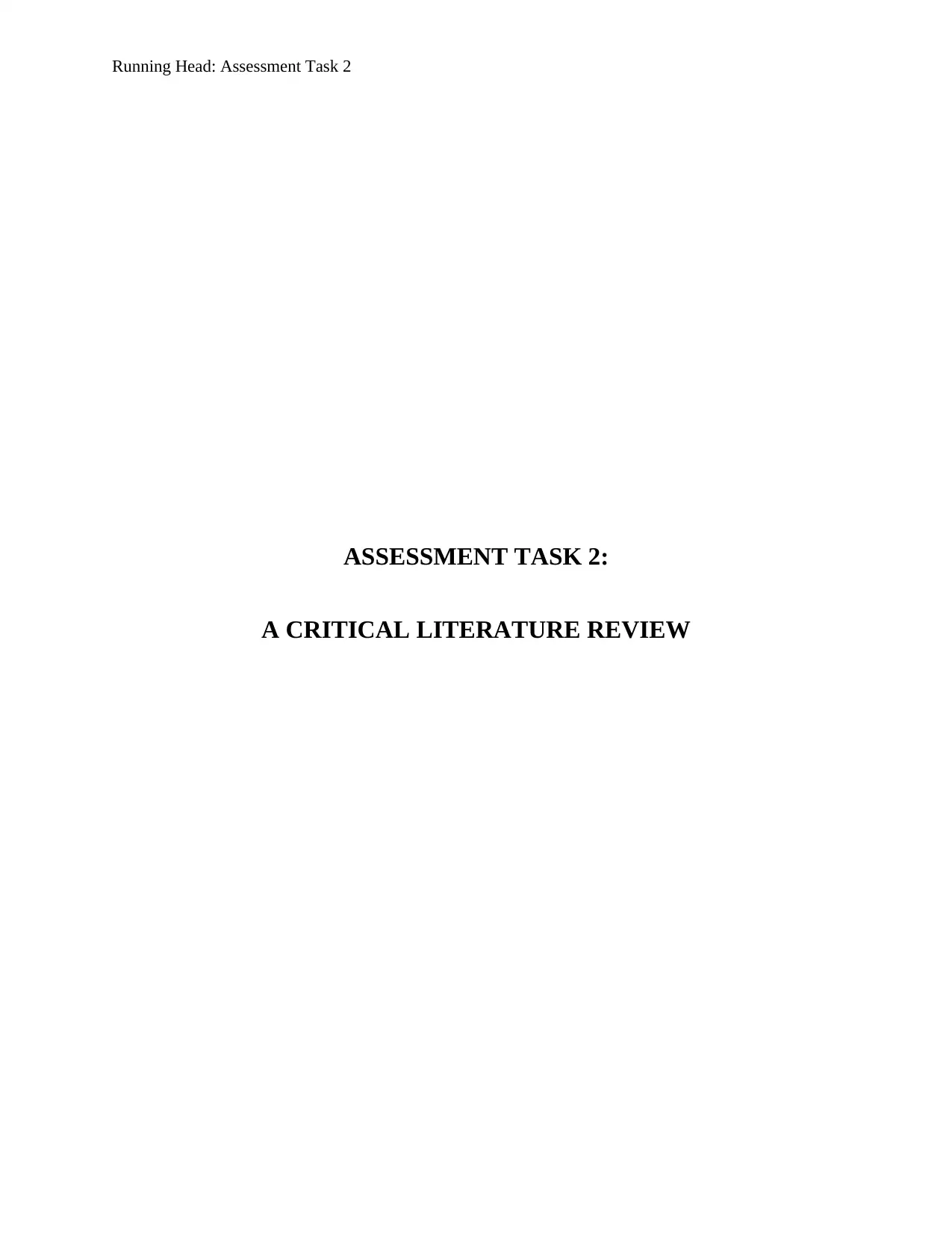
Running Head: Assessment Task 2
ASSESSMENT TASK 2:
A CRITICAL LITERATURE REVIEW
ASSESSMENT TASK 2:
A CRITICAL LITERATURE REVIEW
Paraphrase This Document
Need a fresh take? Get an instant paraphrase of this document with our AI Paraphraser
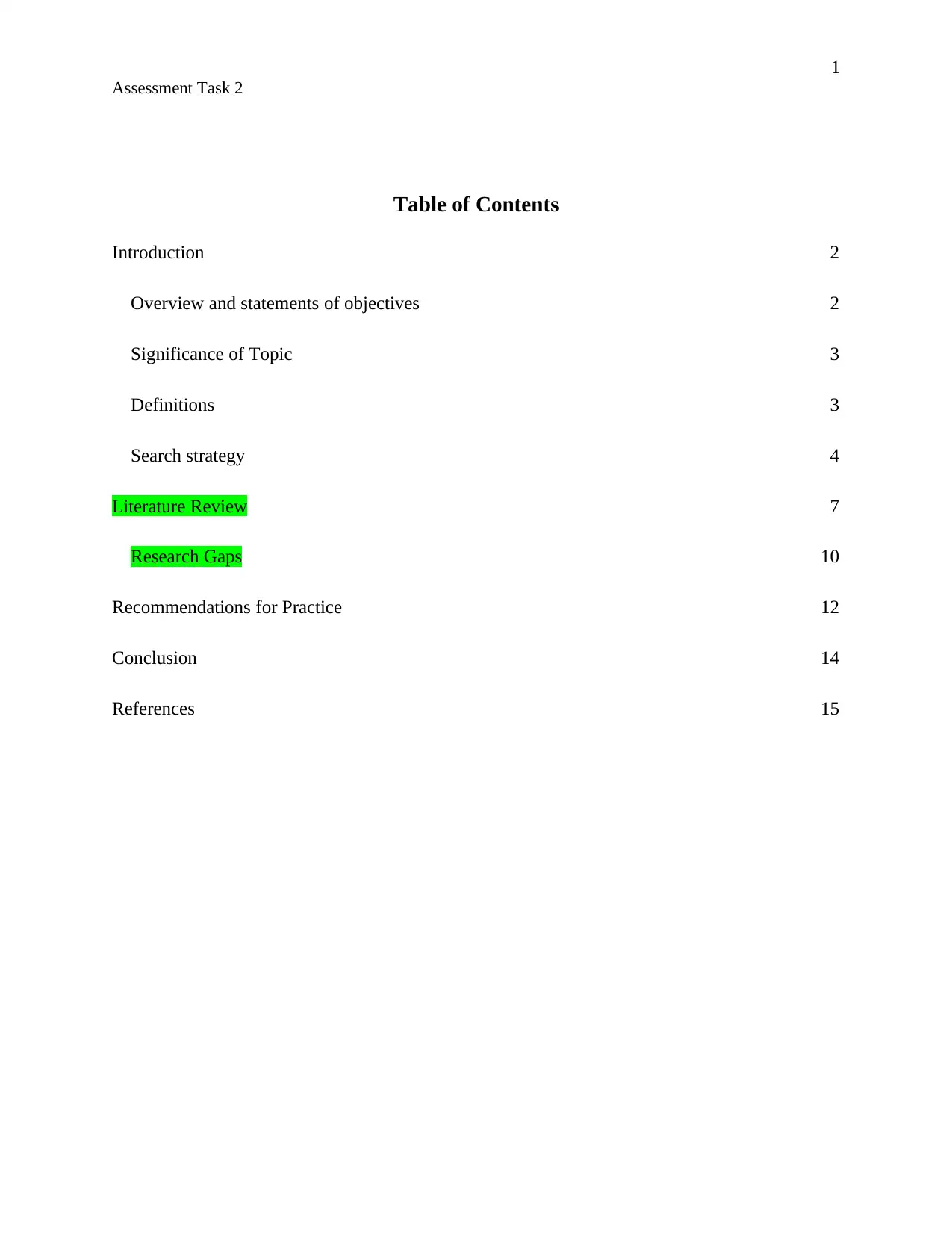
1
Assessment Task 2
Table of Contents
Introduction 2
Overview and statements of objectives 2
Significance of Topic 3
Definitions 3
Search strategy 4
Literature Review 7
Research Gaps 10
Recommendations for Practice 12
Conclusion 14
References 15
Assessment Task 2
Table of Contents
Introduction 2
Overview and statements of objectives 2
Significance of Topic 3
Definitions 3
Search strategy 4
Literature Review 7
Research Gaps 10
Recommendations for Practice 12
Conclusion 14
References 15
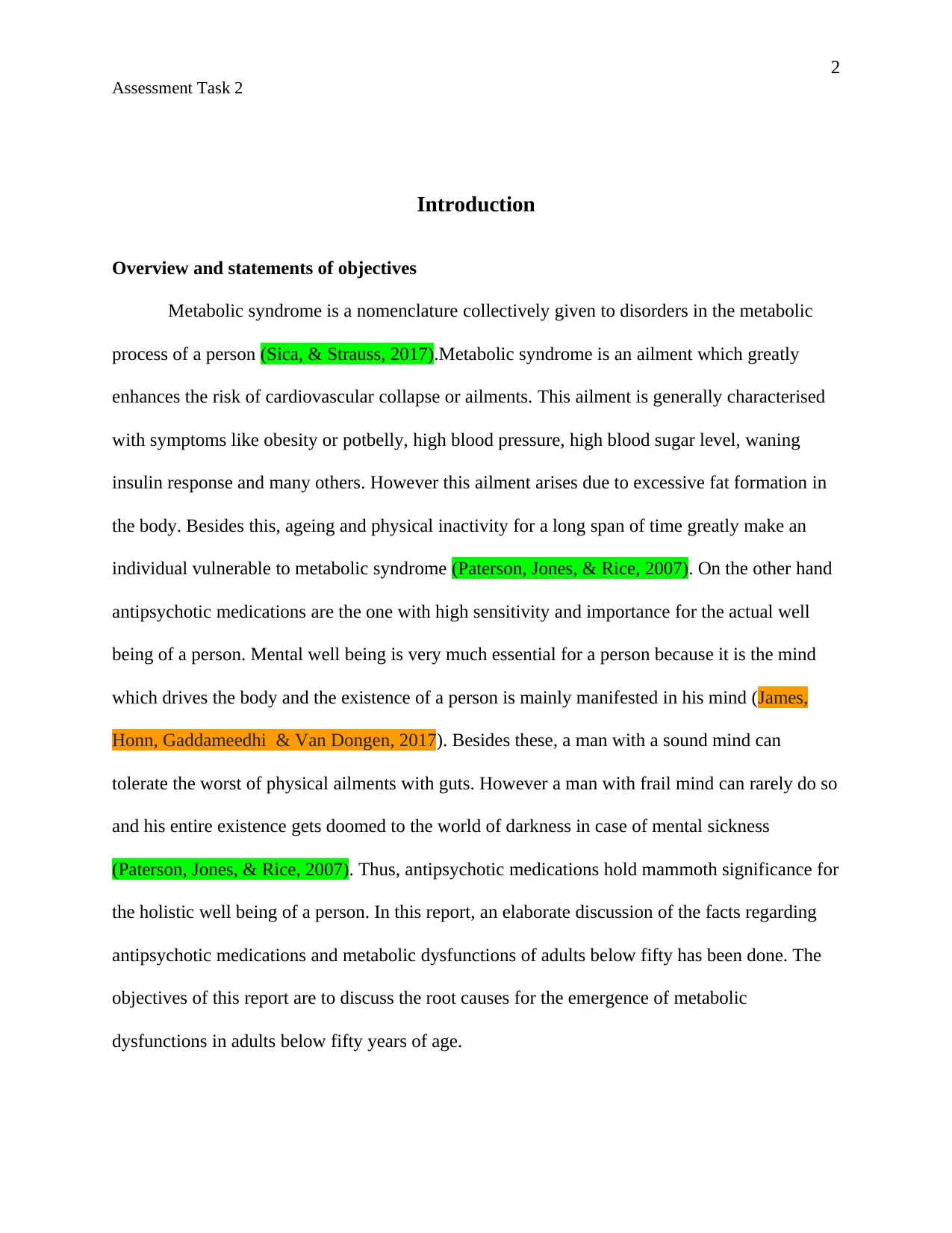
2
Assessment Task 2
Introduction
Overview and statements of objectives
Metabolic syndrome is a nomenclature collectively given to disorders in the metabolic
process of a person (Sica, & Strauss, 2017).Metabolic syndrome is an ailment which greatly
enhances the risk of cardiovascular collapse or ailments. This ailment is generally characterised
with symptoms like obesity or potbelly, high blood pressure, high blood sugar level, waning
insulin response and many others. However this ailment arises due to excessive fat formation in
the body. Besides this, ageing and physical inactivity for a long span of time greatly make an
individual vulnerable to metabolic syndrome (Paterson, Jones, & Rice, 2007). On the other hand
antipsychotic medications are the one with high sensitivity and importance for the actual well
being of a person. Mental well being is very much essential for a person because it is the mind
which drives the body and the existence of a person is mainly manifested in his mind (James,
Honn, Gaddameedhi & Van Dongen, 2017). Besides these, a man with a sound mind can
tolerate the worst of physical ailments with guts. However a man with frail mind can rarely do so
and his entire existence gets doomed to the world of darkness in case of mental sickness
(Paterson, Jones, & Rice, 2007). Thus, antipsychotic medications hold mammoth significance for
the holistic well being of a person. In this report, an elaborate discussion of the facts regarding
antipsychotic medications and metabolic dysfunctions of adults below fifty has been done. The
objectives of this report are to discuss the root causes for the emergence of metabolic
dysfunctions in adults below fifty years of age.
Assessment Task 2
Introduction
Overview and statements of objectives
Metabolic syndrome is a nomenclature collectively given to disorders in the metabolic
process of a person (Sica, & Strauss, 2017).Metabolic syndrome is an ailment which greatly
enhances the risk of cardiovascular collapse or ailments. This ailment is generally characterised
with symptoms like obesity or potbelly, high blood pressure, high blood sugar level, waning
insulin response and many others. However this ailment arises due to excessive fat formation in
the body. Besides this, ageing and physical inactivity for a long span of time greatly make an
individual vulnerable to metabolic syndrome (Paterson, Jones, & Rice, 2007). On the other hand
antipsychotic medications are the one with high sensitivity and importance for the actual well
being of a person. Mental well being is very much essential for a person because it is the mind
which drives the body and the existence of a person is mainly manifested in his mind (James,
Honn, Gaddameedhi & Van Dongen, 2017). Besides these, a man with a sound mind can
tolerate the worst of physical ailments with guts. However a man with frail mind can rarely do so
and his entire existence gets doomed to the world of darkness in case of mental sickness
(Paterson, Jones, & Rice, 2007). Thus, antipsychotic medications hold mammoth significance for
the holistic well being of a person. In this report, an elaborate discussion of the facts regarding
antipsychotic medications and metabolic dysfunctions of adults below fifty has been done. The
objectives of this report are to discuss the root causes for the emergence of metabolic
dysfunctions in adults below fifty years of age.
⊘ This is a preview!⊘
Do you want full access?
Subscribe today to unlock all pages.

Trusted by 1+ million students worldwide
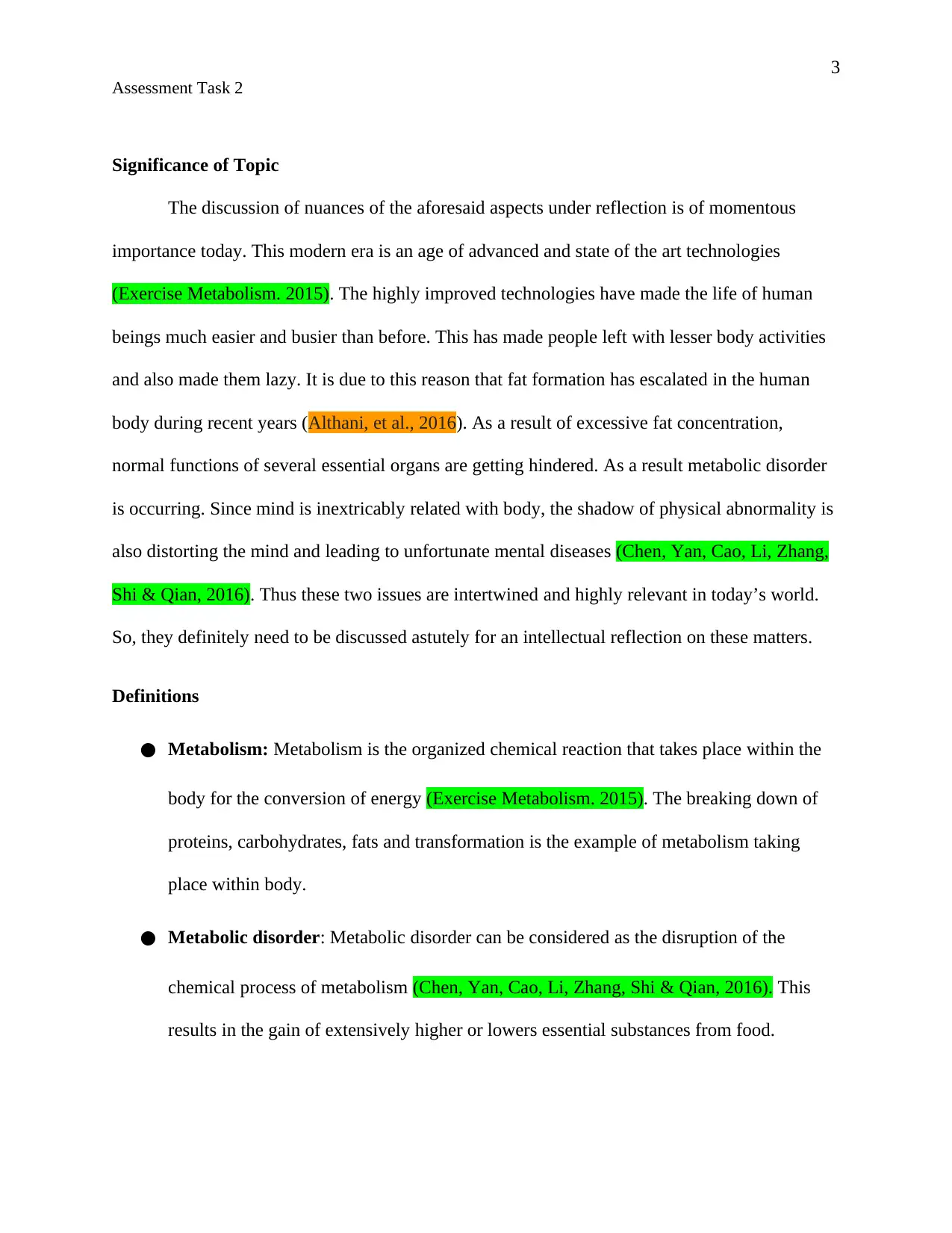
3
Assessment Task 2
Significance of Topic
The discussion of nuances of the aforesaid aspects under reflection is of momentous
importance today. This modern era is an age of advanced and state of the art technologies
(Exercise Metabolism. 2015). The highly improved technologies have made the life of human
beings much easier and busier than before. This has made people left with lesser body activities
and also made them lazy. It is due to this reason that fat formation has escalated in the human
body during recent years (Althani, et al., 2016). As a result of excessive fat concentration,
normal functions of several essential organs are getting hindered. As a result metabolic disorder
is occurring. Since mind is inextricably related with body, the shadow of physical abnormality is
also distorting the mind and leading to unfortunate mental diseases (Chen, Yan, Cao, Li, Zhang,
Shi & Qian, 2016). Thus these two issues are intertwined and highly relevant in today’s world.
So, they definitely need to be discussed astutely for an intellectual reflection on these matters.
Definitions
● Metabolism: Metabolism is the organized chemical reaction that takes place within the
body for the conversion of energy (Exercise Metabolism. 2015). The breaking down of
proteins, carbohydrates, fats and transformation is the example of metabolism taking
place within body.
● Metabolic disorder: Metabolic disorder can be considered as the disruption of the
chemical process of metabolism (Chen, Yan, Cao, Li, Zhang, Shi & Qian, 2016). This
results in the gain of extensively higher or lowers essential substances from food.
Assessment Task 2
Significance of Topic
The discussion of nuances of the aforesaid aspects under reflection is of momentous
importance today. This modern era is an age of advanced and state of the art technologies
(Exercise Metabolism. 2015). The highly improved technologies have made the life of human
beings much easier and busier than before. This has made people left with lesser body activities
and also made them lazy. It is due to this reason that fat formation has escalated in the human
body during recent years (Althani, et al., 2016). As a result of excessive fat concentration,
normal functions of several essential organs are getting hindered. As a result metabolic disorder
is occurring. Since mind is inextricably related with body, the shadow of physical abnormality is
also distorting the mind and leading to unfortunate mental diseases (Chen, Yan, Cao, Li, Zhang,
Shi & Qian, 2016). Thus these two issues are intertwined and highly relevant in today’s world.
So, they definitely need to be discussed astutely for an intellectual reflection on these matters.
Definitions
● Metabolism: Metabolism is the organized chemical reaction that takes place within the
body for the conversion of energy (Exercise Metabolism. 2015). The breaking down of
proteins, carbohydrates, fats and transformation is the example of metabolism taking
place within body.
● Metabolic disorder: Metabolic disorder can be considered as the disruption of the
chemical process of metabolism (Chen, Yan, Cao, Li, Zhang, Shi & Qian, 2016). This
results in the gain of extensively higher or lowers essential substances from food.
Paraphrase This Document
Need a fresh take? Get an instant paraphrase of this document with our AI Paraphraser
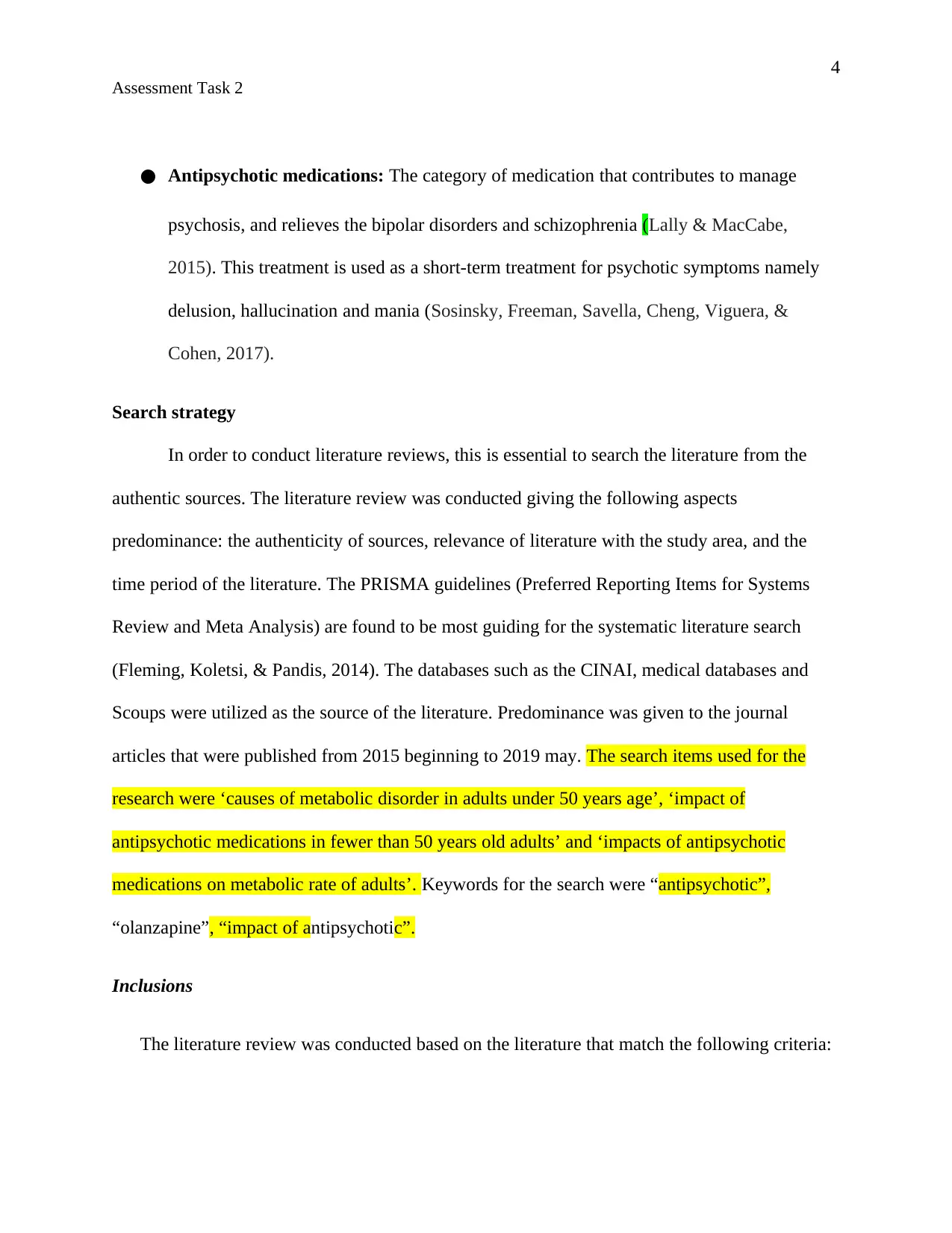
4
Assessment Task 2
● Antipsychotic medications: The category of medication that contributes to manage
psychosis, and relieves the bipolar disorders and schizophrenia (Lally & MacCabe,
2015). This treatment is used as a short-term treatment for psychotic symptoms namely
delusion, hallucination and mania (Sosinsky, Freeman, Savella, Cheng, Viguera, &
Cohen, 2017).
Search strategy
In order to conduct literature reviews, this is essential to search the literature from the
authentic sources. The literature review was conducted giving the following aspects
predominance: the authenticity of sources, relevance of literature with the study area, and the
time period of the literature. The PRISMA guidelines (Preferred Reporting Items for Systems
Review and Meta Analysis) are found to be most guiding for the systematic literature search
(Fleming, Koletsi, & Pandis, 2014). The databases such as the CINAI, medical databases and
Scoups were utilized as the source of the literature. Predominance was given to the journal
articles that were published from 2015 beginning to 2019 may. The search items used for the
research were ‘causes of metabolic disorder in adults under 50 years age’, ‘impact of
antipsychotic medications in fewer than 50 years old adults’ and ‘impacts of antipsychotic
medications on metabolic rate of adults’. Keywords for the search were “antipsychotic”,
“olanzapine”, “impact of antipsychotic”.
Inclusions
The literature review was conducted based on the literature that match the following criteria:
Assessment Task 2
● Antipsychotic medications: The category of medication that contributes to manage
psychosis, and relieves the bipolar disorders and schizophrenia (Lally & MacCabe,
2015). This treatment is used as a short-term treatment for psychotic symptoms namely
delusion, hallucination and mania (Sosinsky, Freeman, Savella, Cheng, Viguera, &
Cohen, 2017).
Search strategy
In order to conduct literature reviews, this is essential to search the literature from the
authentic sources. The literature review was conducted giving the following aspects
predominance: the authenticity of sources, relevance of literature with the study area, and the
time period of the literature. The PRISMA guidelines (Preferred Reporting Items for Systems
Review and Meta Analysis) are found to be most guiding for the systematic literature search
(Fleming, Koletsi, & Pandis, 2014). The databases such as the CINAI, medical databases and
Scoups were utilized as the source of the literature. Predominance was given to the journal
articles that were published from 2015 beginning to 2019 may. The search items used for the
research were ‘causes of metabolic disorder in adults under 50 years age’, ‘impact of
antipsychotic medications in fewer than 50 years old adults’ and ‘impacts of antipsychotic
medications on metabolic rate of adults’. Keywords for the search were “antipsychotic”,
“olanzapine”, “impact of antipsychotic”.
Inclusions
The literature review was conducted based on the literature that match the following criteria:
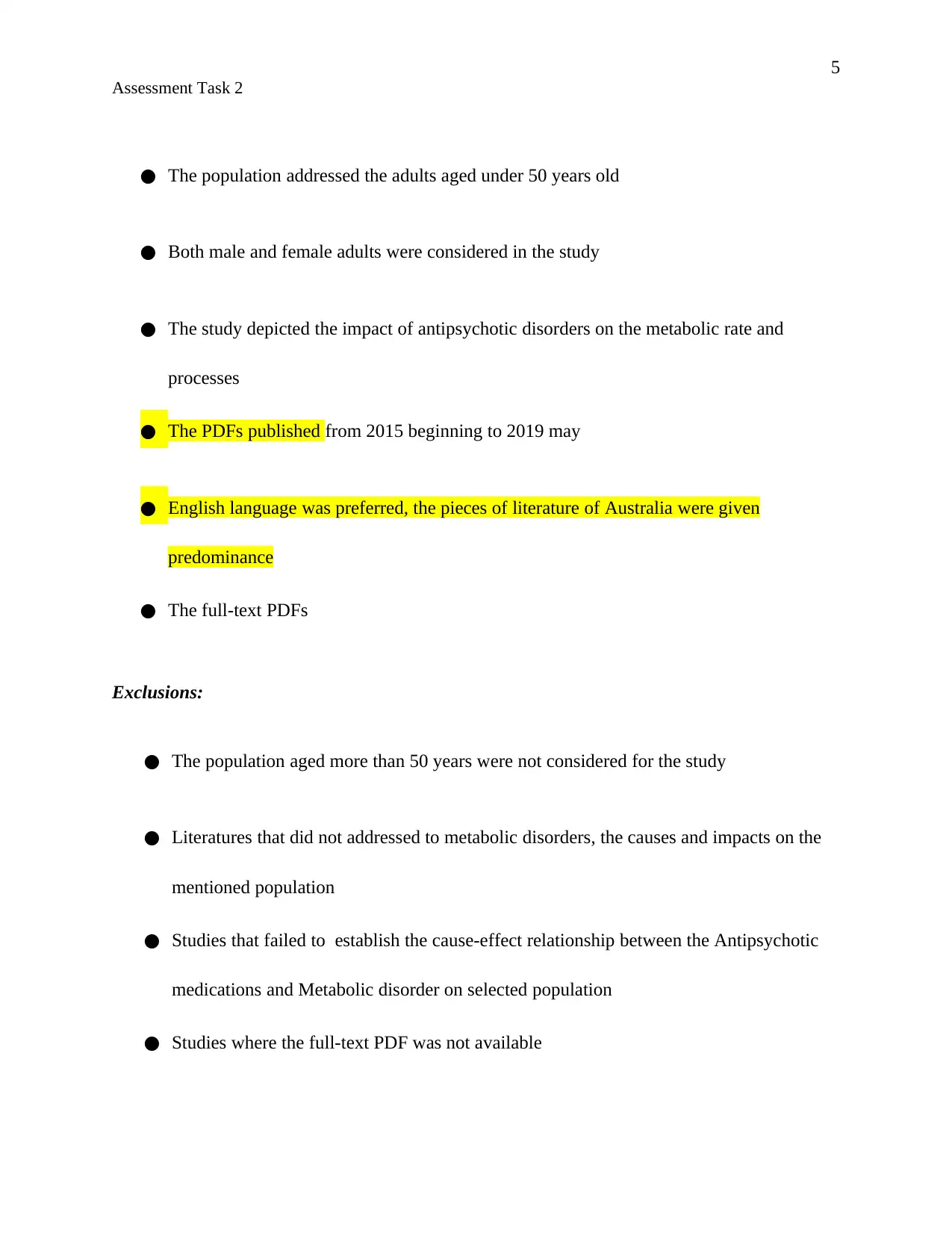
5
Assessment Task 2
● The population addressed the adults aged under 50 years old
● Both male and female adults were considered in the study
● The study depicted the impact of antipsychotic disorders on the metabolic rate and
processes
● The PDFs published from 2015 beginning to 2019 may
● English language was preferred, the pieces of literature of Australia were given
predominance
● The full-text PDFs
Exclusions:
● The population aged more than 50 years were not considered for the study
● Literatures that did not addressed to metabolic disorders, the causes and impacts on the
mentioned population
● Studies that failed to establish the cause-effect relationship between the Antipsychotic
medications and Metabolic disorder on selected population
● Studies where the full-text PDF was not available
Assessment Task 2
● The population addressed the adults aged under 50 years old
● Both male and female adults were considered in the study
● The study depicted the impact of antipsychotic disorders on the metabolic rate and
processes
● The PDFs published from 2015 beginning to 2019 may
● English language was preferred, the pieces of literature of Australia were given
predominance
● The full-text PDFs
Exclusions:
● The population aged more than 50 years were not considered for the study
● Literatures that did not addressed to metabolic disorders, the causes and impacts on the
mentioned population
● Studies that failed to establish the cause-effect relationship between the Antipsychotic
medications and Metabolic disorder on selected population
● Studies where the full-text PDF was not available
⊘ This is a preview!⊘
Do you want full access?
Subscribe today to unlock all pages.

Trusted by 1+ million students worldwide
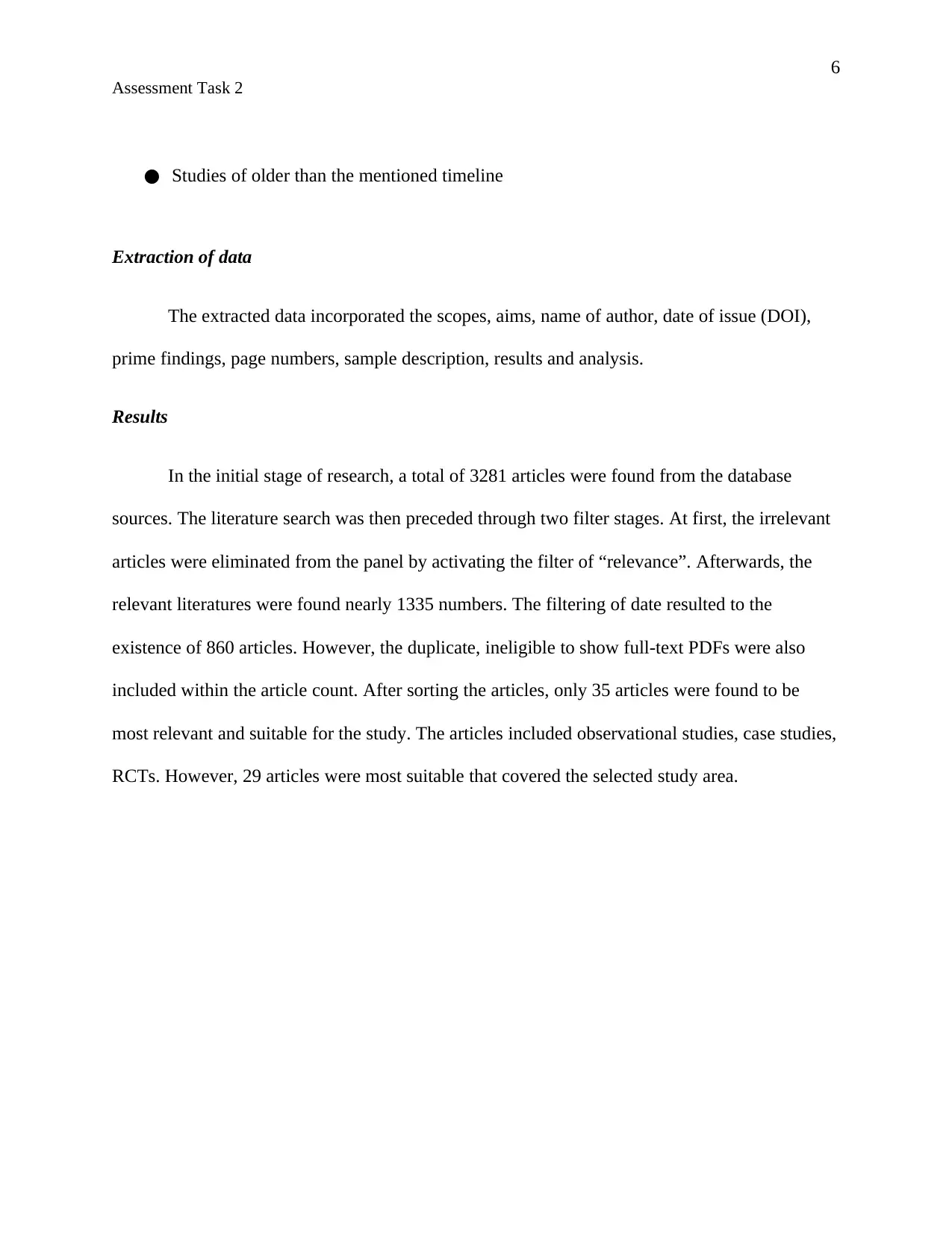
6
Assessment Task 2
● Studies of older than the mentioned timeline
Extraction of data
The extracted data incorporated the scopes, aims, name of author, date of issue (DOI),
prime findings, page numbers, sample description, results and analysis.
Results
In the initial stage of research, a total of 3281 articles were found from the database
sources. The literature search was then preceded through two filter stages. At first, the irrelevant
articles were eliminated from the panel by activating the filter of “relevance”. Afterwards, the
relevant literatures were found nearly 1335 numbers. The filtering of date resulted to the
existence of 860 articles. However, the duplicate, ineligible to show full-text PDFs were also
included within the article count. After sorting the articles, only 35 articles were found to be
most relevant and suitable for the study. The articles included observational studies, case studies,
RCTs. However, 29 articles were most suitable that covered the selected study area.
Assessment Task 2
● Studies of older than the mentioned timeline
Extraction of data
The extracted data incorporated the scopes, aims, name of author, date of issue (DOI),
prime findings, page numbers, sample description, results and analysis.
Results
In the initial stage of research, a total of 3281 articles were found from the database
sources. The literature search was then preceded through two filter stages. At first, the irrelevant
articles were eliminated from the panel by activating the filter of “relevance”. Afterwards, the
relevant literatures were found nearly 1335 numbers. The filtering of date resulted to the
existence of 860 articles. However, the duplicate, ineligible to show full-text PDFs were also
included within the article count. After sorting the articles, only 35 articles were found to be
most relevant and suitable for the study. The articles included observational studies, case studies,
RCTs. However, 29 articles were most suitable that covered the selected study area.
Paraphrase This Document
Need a fresh take? Get an instant paraphrase of this document with our AI Paraphraser
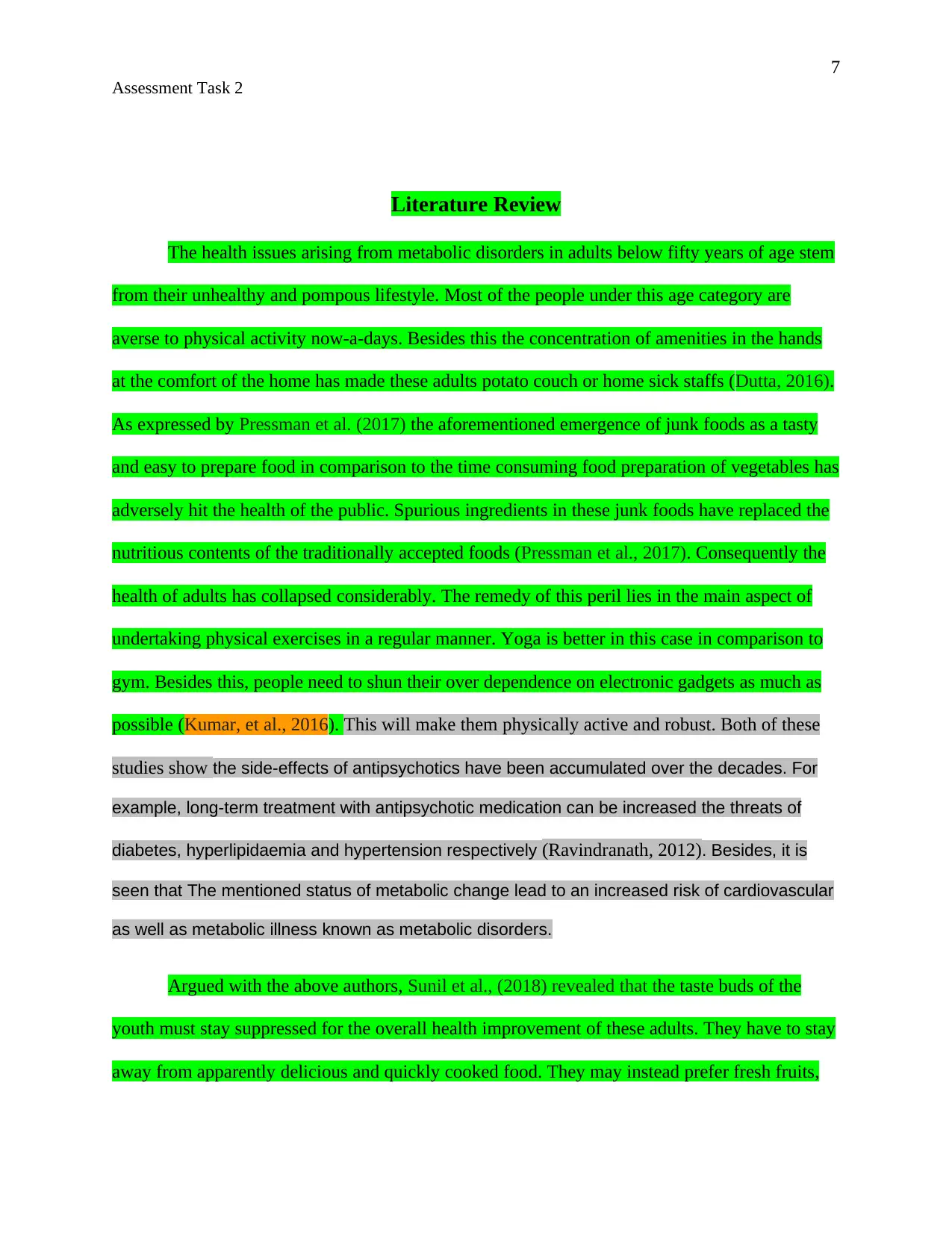
7
Assessment Task 2
Literature Review
The health issues arising from metabolic disorders in adults below fifty years of age stem
from their unhealthy and pompous lifestyle. Most of the people under this age category are
averse to physical activity now-a-days. Besides this the concentration of amenities in the hands
at the comfort of the home has made these adults potato couch or home sick staffs (Dutta, 2016).
As expressed by Pressman et al. (2017) the aforementioned emergence of junk foods as a tasty
and easy to prepare food in comparison to the time consuming food preparation of vegetables has
adversely hit the health of the public. Spurious ingredients in these junk foods have replaced the
nutritious contents of the traditionally accepted foods (Pressman et al., 2017). Consequently the
health of adults has collapsed considerably. The remedy of this peril lies in the main aspect of
undertaking physical exercises in a regular manner. Yoga is better in this case in comparison to
gym. Besides this, people need to shun their over dependence on electronic gadgets as much as
possible (Kumar, et al., 2016). This will make them physically active and robust. Both of these
studies show the side-effects of antipsychotics have been accumulated over the decades. For
example, long-term treatment with antipsychotic medication can be increased the threats of
diabetes, hyperlipidaemia and hypertension respectively (Ravindranath, 2012). Besides, it is
seen that The mentioned status of metabolic change lead to an increased risk of cardiovascular
as well as metabolic illness known as metabolic disorders.
Argued with the above authors, Sunil et al., (2018) revealed that the taste buds of the
youth must stay suppressed for the overall health improvement of these adults. They have to stay
away from apparently delicious and quickly cooked food. They may instead prefer fresh fruits,
Assessment Task 2
Literature Review
The health issues arising from metabolic disorders in adults below fifty years of age stem
from their unhealthy and pompous lifestyle. Most of the people under this age category are
averse to physical activity now-a-days. Besides this the concentration of amenities in the hands
at the comfort of the home has made these adults potato couch or home sick staffs (Dutta, 2016).
As expressed by Pressman et al. (2017) the aforementioned emergence of junk foods as a tasty
and easy to prepare food in comparison to the time consuming food preparation of vegetables has
adversely hit the health of the public. Spurious ingredients in these junk foods have replaced the
nutritious contents of the traditionally accepted foods (Pressman et al., 2017). Consequently the
health of adults has collapsed considerably. The remedy of this peril lies in the main aspect of
undertaking physical exercises in a regular manner. Yoga is better in this case in comparison to
gym. Besides this, people need to shun their over dependence on electronic gadgets as much as
possible (Kumar, et al., 2016). This will make them physically active and robust. Both of these
studies show the side-effects of antipsychotics have been accumulated over the decades. For
example, long-term treatment with antipsychotic medication can be increased the threats of
diabetes, hyperlipidaemia and hypertension respectively (Ravindranath, 2012). Besides, it is
seen that The mentioned status of metabolic change lead to an increased risk of cardiovascular
as well as metabolic illness known as metabolic disorders.
Argued with the above authors, Sunil et al., (2018) revealed that the taste buds of the
youth must stay suppressed for the overall health improvement of these adults. They have to stay
away from apparently delicious and quickly cooked food. They may instead prefer fresh fruits,
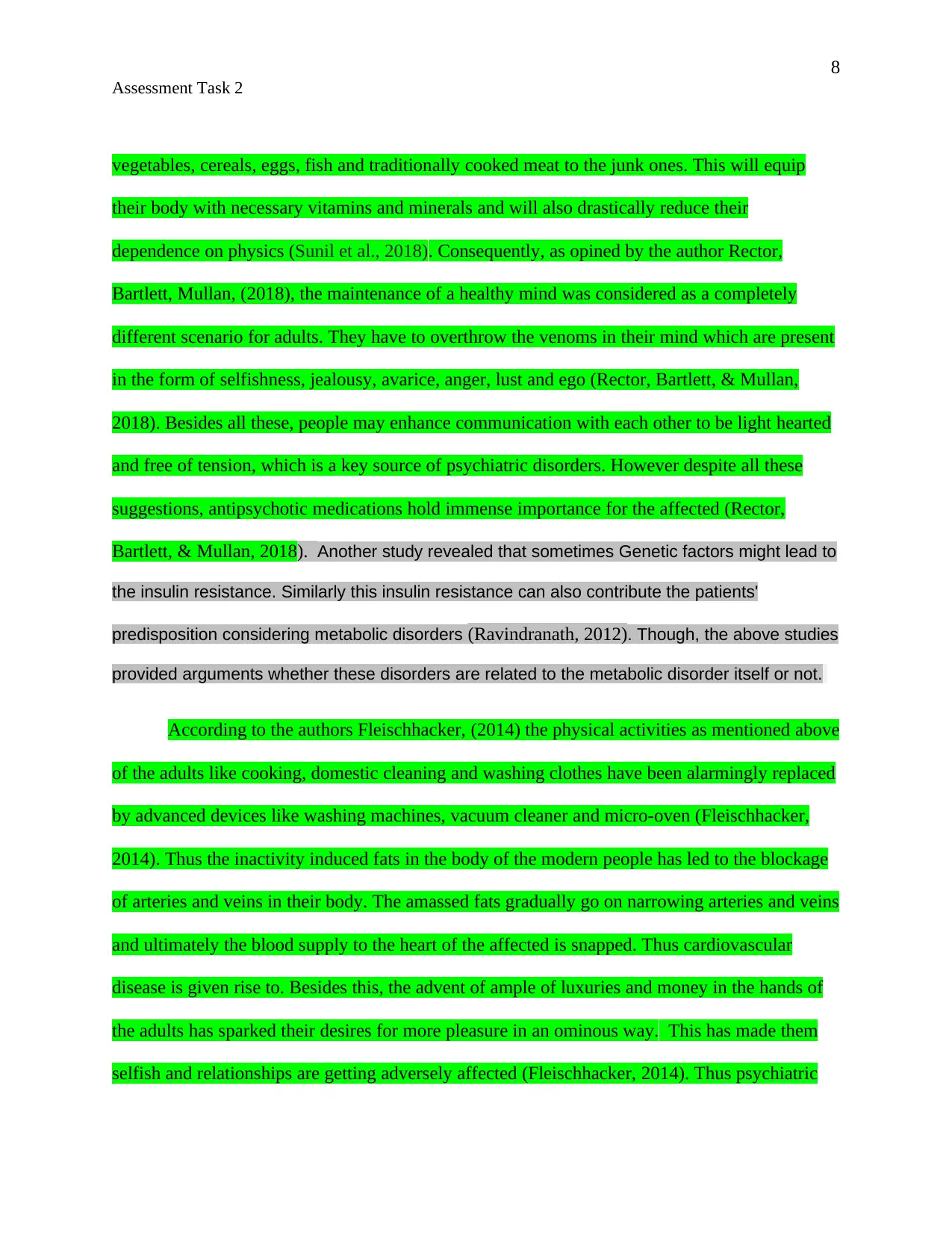
8
Assessment Task 2
vegetables, cereals, eggs, fish and traditionally cooked meat to the junk ones. This will equip
their body with necessary vitamins and minerals and will also drastically reduce their
dependence on physics (Sunil et al., 2018). Consequently, as opined by the author Rector,
Bartlett, Mullan, (2018), the maintenance of a healthy mind was considered as a completely
different scenario for adults. They have to overthrow the venoms in their mind which are present
in the form of selfishness, jealousy, avarice, anger, lust and ego (Rector, Bartlett, & Mullan,
2018). Besides all these, people may enhance communication with each other to be light hearted
and free of tension, which is a key source of psychiatric disorders. However despite all these
suggestions, antipsychotic medications hold immense importance for the affected (Rector,
Bartlett, & Mullan, 2018). Another study revealed that sometimes Genetic factors might lead to
the insulin resistance. Similarly this insulin resistance can also contribute the patients'
predisposition considering metabolic disorders (Ravindranath, 2012). Though, the above studies
provided arguments whether these disorders are related to the metabolic disorder itself or not.
According to the authors Fleischhacker, (2014) the physical activities as mentioned above
of the adults like cooking, domestic cleaning and washing clothes have been alarmingly replaced
by advanced devices like washing machines, vacuum cleaner and micro-oven (Fleischhacker,
2014). Thus the inactivity induced fats in the body of the modern people has led to the blockage
of arteries and veins in their body. The amassed fats gradually go on narrowing arteries and veins
and ultimately the blood supply to the heart of the affected is snapped. Thus cardiovascular
disease is given rise to. Besides this, the advent of ample of luxuries and money in the hands of
the adults has sparked their desires for more pleasure in an ominous way. This has made them
selfish and relationships are getting adversely affected (Fleischhacker, 2014). Thus psychiatric
Assessment Task 2
vegetables, cereals, eggs, fish and traditionally cooked meat to the junk ones. This will equip
their body with necessary vitamins and minerals and will also drastically reduce their
dependence on physics (Sunil et al., 2018). Consequently, as opined by the author Rector,
Bartlett, Mullan, (2018), the maintenance of a healthy mind was considered as a completely
different scenario for adults. They have to overthrow the venoms in their mind which are present
in the form of selfishness, jealousy, avarice, anger, lust and ego (Rector, Bartlett, & Mullan,
2018). Besides all these, people may enhance communication with each other to be light hearted
and free of tension, which is a key source of psychiatric disorders. However despite all these
suggestions, antipsychotic medications hold immense importance for the affected (Rector,
Bartlett, & Mullan, 2018). Another study revealed that sometimes Genetic factors might lead to
the insulin resistance. Similarly this insulin resistance can also contribute the patients'
predisposition considering metabolic disorders (Ravindranath, 2012). Though, the above studies
provided arguments whether these disorders are related to the metabolic disorder itself or not.
According to the authors Fleischhacker, (2014) the physical activities as mentioned above
of the adults like cooking, domestic cleaning and washing clothes have been alarmingly replaced
by advanced devices like washing machines, vacuum cleaner and micro-oven (Fleischhacker,
2014). Thus the inactivity induced fats in the body of the modern people has led to the blockage
of arteries and veins in their body. The amassed fats gradually go on narrowing arteries and veins
and ultimately the blood supply to the heart of the affected is snapped. Thus cardiovascular
disease is given rise to. Besides this, the advent of ample of luxuries and money in the hands of
the adults has sparked their desires for more pleasure in an ominous way. This has made them
selfish and relationships are getting adversely affected (Fleischhacker, 2014). Thus psychiatric
⊘ This is a preview!⊘
Do you want full access?
Subscribe today to unlock all pages.

Trusted by 1+ million students worldwide
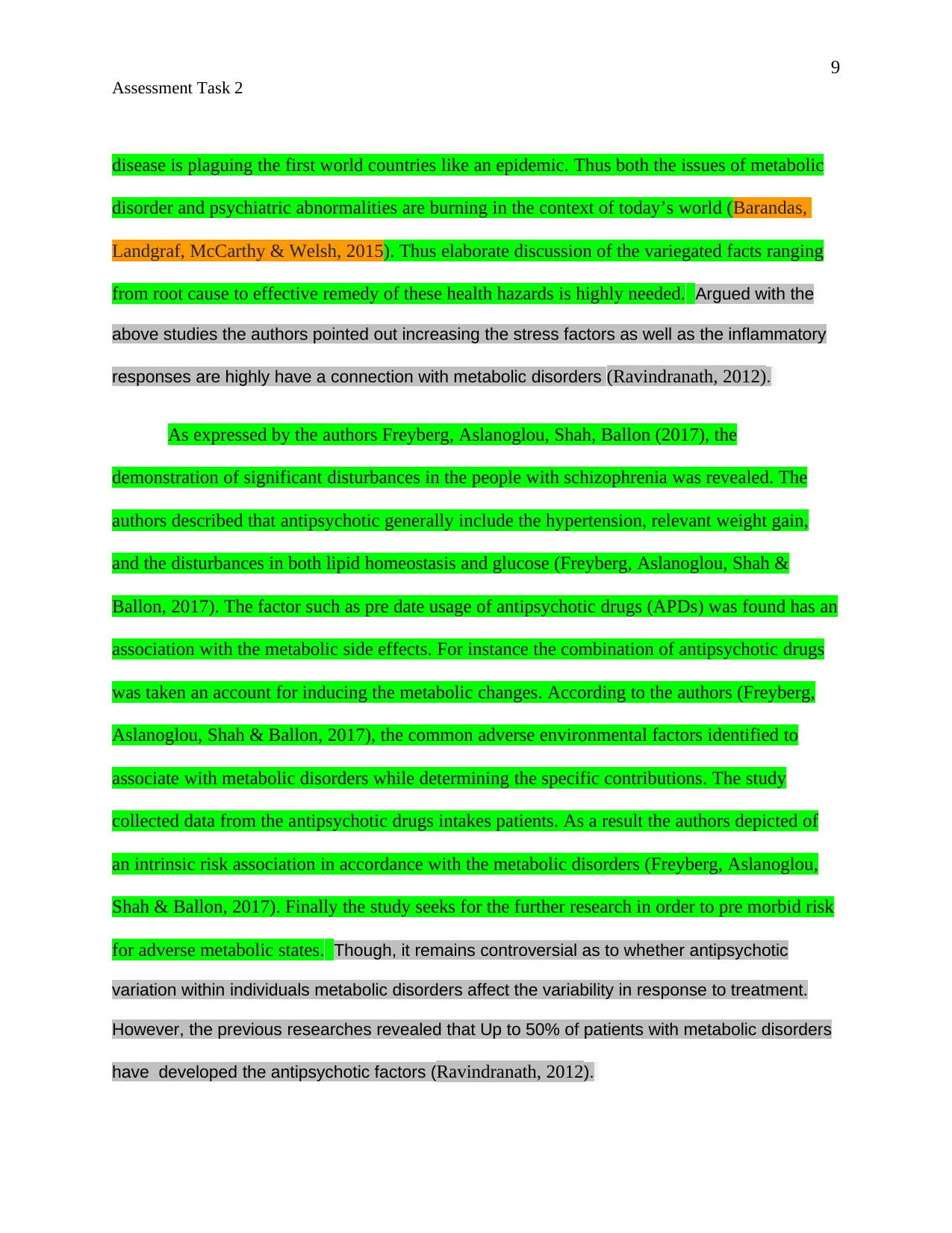
9
Assessment Task 2
disease is plaguing the first world countries like an epidemic. Thus both the issues of metabolic
disorder and psychiatric abnormalities are burning in the context of today’s world (Barandas,
Landgraf, McCarthy & Welsh, 2015). Thus elaborate discussion of the variegated facts ranging
from root cause to effective remedy of these health hazards is highly needed. Argued with the
above studies the authors pointed out increasing the stress factors as well as the inflammatory
responses are highly have a connection with metabolic disorders (Ravindranath, 2012).
As expressed by the authors Freyberg, Aslanoglou, Shah, Ballon (2017), the
demonstration of significant disturbances in the people with schizophrenia was revealed. The
authors described that antipsychotic generally include the hypertension, relevant weight gain,
and the disturbances in both lipid homeostasis and glucose (Freyberg, Aslanoglou, Shah &
Ballon, 2017). The factor such as pre date usage of antipsychotic drugs (APDs) was found has an
association with the metabolic side effects. For instance the combination of antipsychotic drugs
was taken an account for inducing the metabolic changes. According to the authors (Freyberg,
Aslanoglou, Shah & Ballon, 2017), the common adverse environmental factors identified to
associate with metabolic disorders while determining the specific contributions. The study
collected data from the antipsychotic drugs intakes patients. As a result the authors depicted of
an intrinsic risk association in accordance with the metabolic disorders (Freyberg, Aslanoglou,
Shah & Ballon, 2017). Finally the study seeks for the further research in order to pre morbid risk
for adverse metabolic states. Though, it remains controversial as to whether antipsychotic
variation within individuals metabolic disorders affect the variability in response to treatment.
However, the previous researches revealed that Up to 50% of patients with metabolic disorders
have developed the antipsychotic factors (Ravindranath, 2012).
Assessment Task 2
disease is plaguing the first world countries like an epidemic. Thus both the issues of metabolic
disorder and psychiatric abnormalities are burning in the context of today’s world (Barandas,
Landgraf, McCarthy & Welsh, 2015). Thus elaborate discussion of the variegated facts ranging
from root cause to effective remedy of these health hazards is highly needed. Argued with the
above studies the authors pointed out increasing the stress factors as well as the inflammatory
responses are highly have a connection with metabolic disorders (Ravindranath, 2012).
As expressed by the authors Freyberg, Aslanoglou, Shah, Ballon (2017), the
demonstration of significant disturbances in the people with schizophrenia was revealed. The
authors described that antipsychotic generally include the hypertension, relevant weight gain,
and the disturbances in both lipid homeostasis and glucose (Freyberg, Aslanoglou, Shah &
Ballon, 2017). The factor such as pre date usage of antipsychotic drugs (APDs) was found has an
association with the metabolic side effects. For instance the combination of antipsychotic drugs
was taken an account for inducing the metabolic changes. According to the authors (Freyberg,
Aslanoglou, Shah & Ballon, 2017), the common adverse environmental factors identified to
associate with metabolic disorders while determining the specific contributions. The study
collected data from the antipsychotic drugs intakes patients. As a result the authors depicted of
an intrinsic risk association in accordance with the metabolic disorders (Freyberg, Aslanoglou,
Shah & Ballon, 2017). Finally the study seeks for the further research in order to pre morbid risk
for adverse metabolic states. Though, it remains controversial as to whether antipsychotic
variation within individuals metabolic disorders affect the variability in response to treatment.
However, the previous researches revealed that Up to 50% of patients with metabolic disorders
have developed the antipsychotic factors (Ravindranath, 2012).
Paraphrase This Document
Need a fresh take? Get an instant paraphrase of this document with our AI Paraphraser
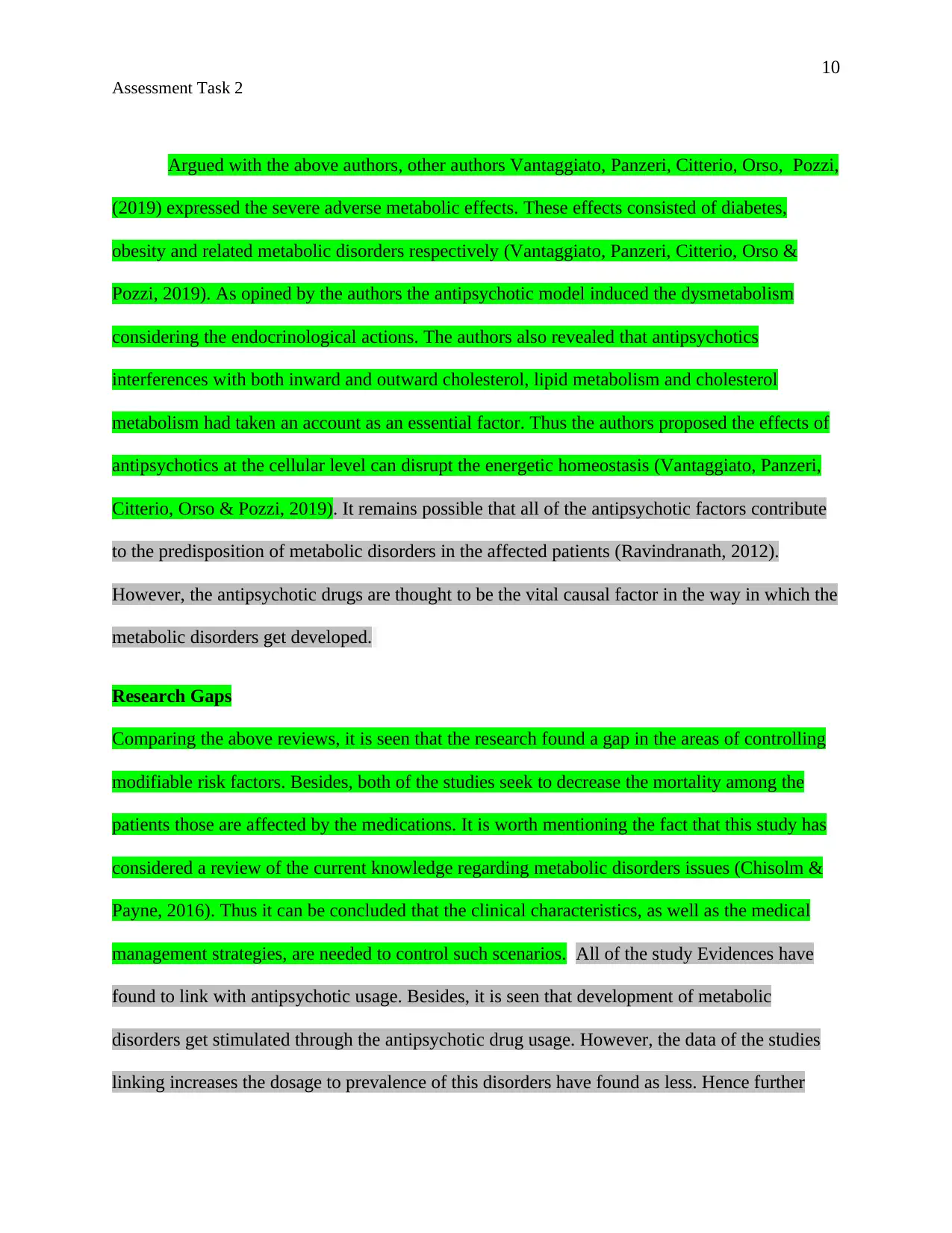
10
Assessment Task 2
Argued with the above authors, other authors Vantaggiato, Panzeri, Citterio, Orso, Pozzi,
(2019) expressed the severe adverse metabolic effects. These effects consisted of diabetes,
obesity and related metabolic disorders respectively (Vantaggiato, Panzeri, Citterio, Orso &
Pozzi, 2019). As opined by the authors the antipsychotic model induced the dysmetabolism
considering the endocrinological actions. The authors also revealed that antipsychotics
interferences with both inward and outward cholesterol, lipid metabolism and cholesterol
metabolism had taken an account as an essential factor. Thus the authors proposed the effects of
antipsychotics at the cellular level can disrupt the energetic homeostasis (Vantaggiato, Panzeri,
Citterio, Orso & Pozzi, 2019). It remains possible that all of the antipsychotic factors contribute
to the predisposition of metabolic disorders in the affected patients (Ravindranath, 2012).
However, the antipsychotic drugs are thought to be the vital causal factor in the way in which the
metabolic disorders get developed.
Research Gaps
Comparing the above reviews, it is seen that the research found a gap in the areas of controlling
modifiable risk factors. Besides, both of the studies seek to decrease the mortality among the
patients those are affected by the medications. It is worth mentioning the fact that this study has
considered a review of the current knowledge regarding metabolic disorders issues (Chisolm &
Payne, 2016). Thus it can be concluded that the clinical characteristics, as well as the medical
management strategies, are needed to control such scenarios. All of the study Evidences have
found to link with antipsychotic usage. Besides, it is seen that development of metabolic
disorders get stimulated through the antipsychotic drug usage. However, the data of the studies
linking increases the dosage to prevalence of this disorders have found as less. Hence further
Assessment Task 2
Argued with the above authors, other authors Vantaggiato, Panzeri, Citterio, Orso, Pozzi,
(2019) expressed the severe adverse metabolic effects. These effects consisted of diabetes,
obesity and related metabolic disorders respectively (Vantaggiato, Panzeri, Citterio, Orso &
Pozzi, 2019). As opined by the authors the antipsychotic model induced the dysmetabolism
considering the endocrinological actions. The authors also revealed that antipsychotics
interferences with both inward and outward cholesterol, lipid metabolism and cholesterol
metabolism had taken an account as an essential factor. Thus the authors proposed the effects of
antipsychotics at the cellular level can disrupt the energetic homeostasis (Vantaggiato, Panzeri,
Citterio, Orso & Pozzi, 2019). It remains possible that all of the antipsychotic factors contribute
to the predisposition of metabolic disorders in the affected patients (Ravindranath, 2012).
However, the antipsychotic drugs are thought to be the vital causal factor in the way in which the
metabolic disorders get developed.
Research Gaps
Comparing the above reviews, it is seen that the research found a gap in the areas of controlling
modifiable risk factors. Besides, both of the studies seek to decrease the mortality among the
patients those are affected by the medications. It is worth mentioning the fact that this study has
considered a review of the current knowledge regarding metabolic disorders issues (Chisolm &
Payne, 2016). Thus it can be concluded that the clinical characteristics, as well as the medical
management strategies, are needed to control such scenarios. All of the study Evidences have
found to link with antipsychotic usage. Besides, it is seen that development of metabolic
disorders get stimulated through the antipsychotic drug usage. However, the data of the studies
linking increases the dosage to prevalence of this disorders have found as less. Hence further

11
Assessment Task 2
research is recommended to evaluate the relationship between antipsychotic and metabolic
disorders.
Assessment Task 2
research is recommended to evaluate the relationship between antipsychotic and metabolic
disorders.
⊘ This is a preview!⊘
Do you want full access?
Subscribe today to unlock all pages.

Trusted by 1+ million students worldwide
1 out of 19
Your All-in-One AI-Powered Toolkit for Academic Success.
+13062052269
info@desklib.com
Available 24*7 on WhatsApp / Email
![[object Object]](/_next/static/media/star-bottom.7253800d.svg)
Unlock your academic potential
Copyright © 2020–2025 A2Z Services. All Rights Reserved. Developed and managed by ZUCOL.